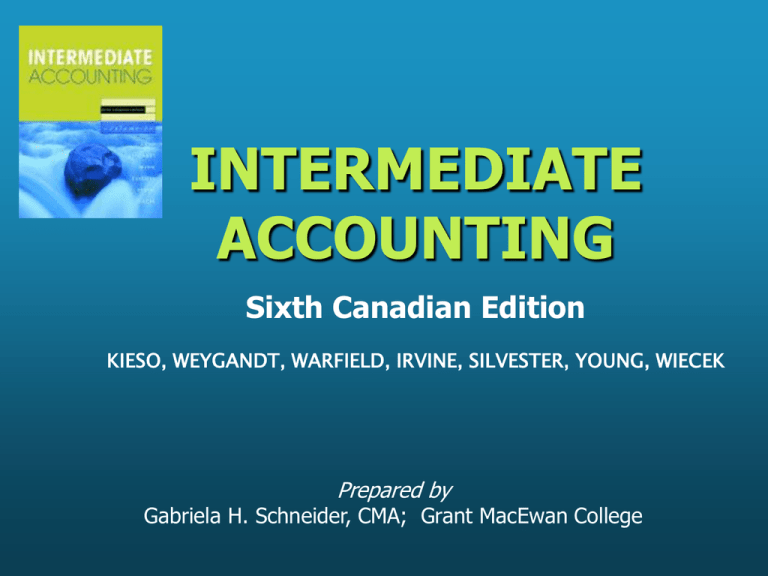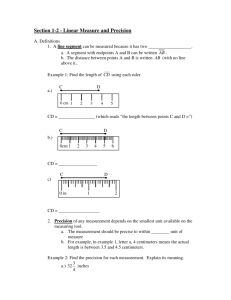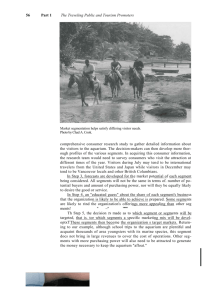
INTERMEDIATE
ACCOUNTING
Sixth Canadian Edition
KIESO, WEYGANDT, WARFIELD, IRVINE, SILVESTER, YOUNG, WIECEK
Prepared by
Gabriela H. Schneider, CMA; Grant MacEwan College
CHAPTER
24
Full Disclosure in
Financial Reporting
Learning Objectives
1. Review the full disclosure principle and describe
problems of implementation.
2. Explain the use of notes in financial statement
preparation.
3. Describe the disclosure requirements for major
segments of a business.
4. Describe the accounting problems associated
with interim reporting.
Learning Objectives
5. Identify the major disclosures found in the
auditor’s report.
6. Understand management’s responsibilities for
financials.
7. Identify issues related to financial forecasts and
projections.
8. Describe the profession’s response to
fraudulent financial reporting.
Full Disclosure in
Financial Reporting
Current
Auditors
Reporting
and
Issues
Management
Reports
Auditor’s
Forecasts or
Increase in Accounting Special
report
projections
reporting
policies
transactions
Internet
Management’s
requireCommon or events
financial
reports
ments
reporting
notes
Post
Diversified
Fraudulent
Differential
balance
companies
financial
disclosure
sheet
reporting
Interim
events
reports
Criteria for
accounting
and reporting
choices
Full
Disclosure
Principle
Notes to
Disclosure
Financial Issues
Statements
The Full Disclosure Principle
• The full disclosure principle calls for financial
reporting of significant facts affecting the
judgment of an informed reader
• The problems of implementing this principle
are costs of disclosure or information overload
• The profession is still in the process of
developing guidelines as to
• whether a given transaction should be disclosed
• what format this disclosure should take
Increase in
Reporting Requirements
• Reasons for increasing reporting
requirements:
• Complexity of the business environment
(derivatives, business combinations,
pensions)
• Need for timely information (interim data,
forecasts)
• Accounting used as a control and monitoring
device
Differential Disclosure
• The OSC requires that companies report certain
important information items (if not found in the
annual report)
• Nonpublic enterprises are exempt from certain
reporting requirements (e.g., segment
reporting)
• Arguments are also made for excluding small
companies from certain complex reporting
requirements (e.g., pensions, deferred taxes)
• CICA is proposing a simplified GAAP; FASB
maintains the position of a single GAAP
Notes to the
Financial Statements
• Notes amplify or explain items presented in
the body of the financial statements
• A statement that identifies the accounting
policies of the entity must be disclosed
(Summary of Significant Accounting Policies)
• Notes to the financial statements include:
• Inventory
• Contingencies and commitments
• Changes in accounting policies
Notes to the
Financial Statements
• Major disclosures
• Inventory
• Property, Plant and
Equipment
• Liabilities
• Equity
• Contingencies and
Commitments
• Taxes, Pensions and
Leases
• Changes in Accounting
Policies
• Special
Transactions or
Events
• Subsequent
events
• Segment
reporting
• Interim
reporting
• Related
party
transactions
• Accounting
errors
• Illegal acts
Related Party Transactions
• Can significantly influence policies
• Measurement is a major accounting and
reporting issue
• Related party transactions are
individually assessed
Related Party Transactions –
Decision Tree
Related party transaction occurs
Is transaction in the
normal course of
operations?
No
Is there a substantive
change in the ownership interests of the
item transferred?
No
Yes
Is the amount of the
Yes exchange supported
Yes
by independent
evidence?
Yes
No
Is there culmination of
the earnings process?
No
Measure at carrying amount
Is the
transaction
non-monetary?
No
Yes
Measure at exchange amount
Related Party Transactions
The following disclosures are recommended:
• The nature of the relationship
• Description of the transactions
• The recorded amounts of transactions
• Measurement basis used
• Amounts due from or due to related parties
at the balance sheet date, and terms and
conditions
• Contractual obligations with related parties
• Contingencies involving related parties
Post-Balance Sheet Events
• Notes to the financial statements must explain
• Any significant financial events that occurred
after the balance sheet date, but before the
issue of the financial statements
Financial statement period
Post balance sheet events
Balance
sheet date
Issue date
Types of Transactions
to be Disclosed
• Two types of post-balance sheet events
must be disclosed
• Events that provide additional evidence
about conditions that existed at balance
sheet date and require adjustment
• e.g., customer’s bankruptcy
• Events that provide evidence about
conditions that did not exist at balance
sheet date and do not require adjustment
• e.g., bond or share issuance
Reporting for Diversified
(Conglomerate) Companies
• Information on how the segment contributes to
the total business operations
• Information from the segment income
statement, balance sheet, and cash flow
statement
• Information about segment’s contribution or
impact on the company’s
• Profitability
• Risk
• Growth potential
• Considerable arguments both for and against
segment reporting
Reporting for Diversified
(Conglomerate) Companies
•
•
What is an operating segment?
Any component of an enterprise that
1. Engages in business activities
•
Earns revenues, incurs expenses
2. Has senior management regularly review
results
•
•
Assess performance
Review resource allocation decisions made
3. Has discrete financial information available
Reporting for Diversified
(Conglomerate) Companies
•
Objectives of reporting segmented
information
1. To better understand performance
2. To better assess future cash flow
prospects
3. To make more informed judgments on
the whole enterprise
Reporting by Conglomerates:
Operating Segments
• CICA Handbook requires that the
financial statements include selected
information on a single basis of
segmentation
• The segments are evident from their
organizational structure (operating
segments)
• This method is called the management
approach
Aggregation of
Operating Segments
• Operating segments may be aggregated if
they have the same basic characteristics
• the nature of the products and services
provided
• the nature of the production process
• the type or class of customer
• the methods of product or service distribution
• the nature of the regulatory environment, if
applicable
Reportable Segments
•
An operating segment is identified as a
reportable segment if it satisfies one or more
of the following criteria
1. The revenue criterion
2. The profit or loss criterion
3. The identifiable assets criterion
•
Two other factors are considered in addition to
the above tests
1. Segment results are 75 percent or more of
combined sales to unrelated customers
2. No more than 10 segments are required to be
disclosed
Reportable Segments
Criterion
Thresholds
Revenue
10 percent or more of the combined
revenue of all operating segments
Profit or loss
10 percent or more of the greater of:
- the combined profit of all operating
segments not showing a loss or
- the combined loss of all operating
segments reporting a loss
Identifiable assets
10 percent or more of the combined
assets of all operating segments
Measurement Principles
• The accounting principles used for segment
reporting and for consolidated statements
need not be the same
• Some accounting principles may not apply at
the segment level
• Common costs are not required to be allocated
among the segments
• Such allocation is arbitrary and may not produce
an objective division of costs among segments
Required Segmented
Information
• General information about its reportable
segments
• Segment profit and loss, assets, and related
information
• Reconciliation of segment revenues, profits
and losses, and segment assets
• Information about products and services and
geographical areas
• Major customers
Interim Reporting
Discrete View
Integral View
• Each interim period
considered as separate
accounting period
• Deferrals and accruals
recognized for each
interim period, without
specific consideration of
the fiscal year
• CICA Handbook
preferred method – with
noted exceptions
• Each interim period
considered a part of the
fiscal accounting period
• Deferrals and accruals
recognized in the interim
period, based on the
respective portion of the
fiscal year
Interim Reporting
•
Annual reports and interim reports must use
the same accounting principles
•
•
Exceptions regarding certain inventory reporting
Minimum disclosure requirements include:
1.
2.
3.
4.
5.
6.
7.
8.
Any noncompliance with GAAP
Accounting policies and methods
Any seasonal or cyclical period considerations
Estimate changes
Reportable segment information
Events subsequent to interim reporting period
Notable events (combinations, reorganization)
Contingencies
Interim Reporting Problem Areas
1. Advertising and similar costs
•
Test is whether the benefits extend beyond the
current interim period. If yes, then defer; otherwise
expense
2. Changes in Accounting
•
•
Changes applied retroactively to prior interim periods
Comparable interim periods from previous fiscal years
also restated
3. Earnings per share
•
Each interim period EPS is stand alone
4. Seasonality
5. Continuing Controversy
Auditor’s Reporting Standards
CICA Handbook, Section 5100
1. Identify the financial statements
•
Distinguish management and auditor’s
responsibilities
2. Describe scope of the auditor’s examination
3. State either an opinion or statement that an
opinion cannot be expressed
• If an opinion is provided, it should state
whether the statement fairly presents the
financial position, operating results, and cash
flows in accordance with GAAP
Auditor’s Opinion
The auditor can render or provide
•
•
•
•
An Unqualified (clean) opinion
A Qualified opinion
An Adverse opinion (circumstances)
A disclaimer of an opinion (no opinion can
be given)
Management’s Report
Management’s Discussion and Analysis (MD&A)
•
Covers three aspects of an enterprise
1. Liquidity
2. Capital resources
3. Results of operations
•
•
Identifies favourable or unfavourable trends
Identifies any significant events and uncertainties
that affect the three aspects
Management’s Report
MD&A raises continuing discussion and
questions
1. Is sufficient forward-looking information
disclosed?
2. Should disclosures become
more of a risk analysis?
3. Should the report be
externally audited?
Financial Forecasts
and Projections
• The investing public needs a greater quantity
and quality of information about corporate
expectations
• The disclosures take one of two forms
• Financial forecast of an entity’s expected financial
position
• Financial projection based on hypothetical
assumptions
• The difference is one of likelihood of
happening
Forecast Arguments
For
Against
• Information about the
future facilitates better
decisions
• Corporate disclosures
limit the speculation
about forecasts that are
informally circulated
• Historical information
may not be adequate in
a world of frequently
changing circumstances
• Information about the
future may be misleading
and unreliable
• Corporations may strive
to meet published
projections regardless of
shareholders’ interests
• Incorrect projections may
lead to legal actions
• Forecasts may provide
information to
competitors that may be
detrimental to corporate
interests
Internet Financial Reporting
• Companies are increasingly disclosing
financial information through websites
• Corporations can reach more users by the
Internet
• Internet reporting can make traditional
reports more useful
• Corporations can report more timely information
• They can also report disaggregated data
• There is concern about security on the
Internet (hackers)
Fraudulent Financial
Reporting
Issues of Fraudulent Financial Reporting
• How well are accounting practices and
disclosures serving the public?
• Are auditors meeting their obligations?
• What are the effects of the SEC’s policies?
• What are the effects of regulatory accounting
policies?
• What legislative proposals are needed to
correct perceived weaknesses?
Fraudulent Financial
Reporting
Opportunities exist when:
1. Board of directors or audit committee are
absent
2. Internal accounting controls are weak or
nonexistent
3. Unusual or complex transactions
4. Accounting estimates made with significant
subjective judgment
5. Internal audit staff ineffective
COPYRIGHT
Copyright © 2002 John Wiley & Sons Canada, Ltd.
All rights reserved. Reproduction or translation of
this work beyond that permitted by CANCOPY
(Canadian Reprography Collective) is unlawful.
Request for further information should be
addressed to the Permissions Department, John
Wiley & Sons Canada, Ltd. The purchaser may
make back-up copies for his / her own use only and
not for distribution or resale. The author and the
publisher assume no responsibility for errors,
omissions, or damages, caused by the use of these
programs or from the use of the information
contained herein.









